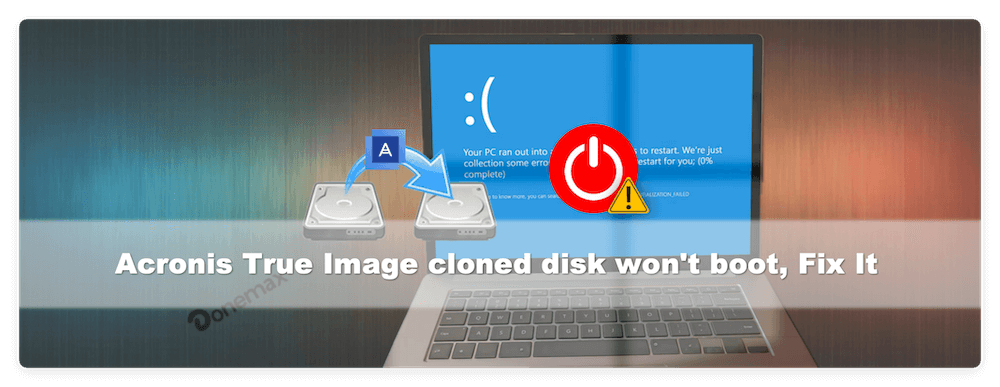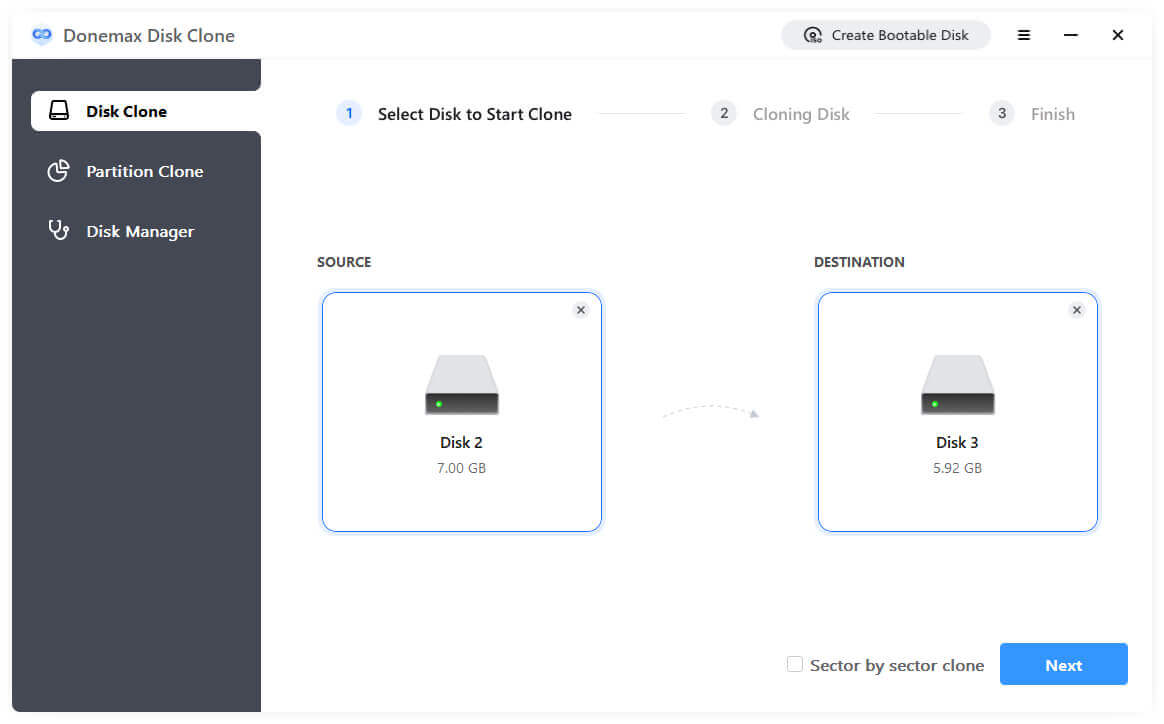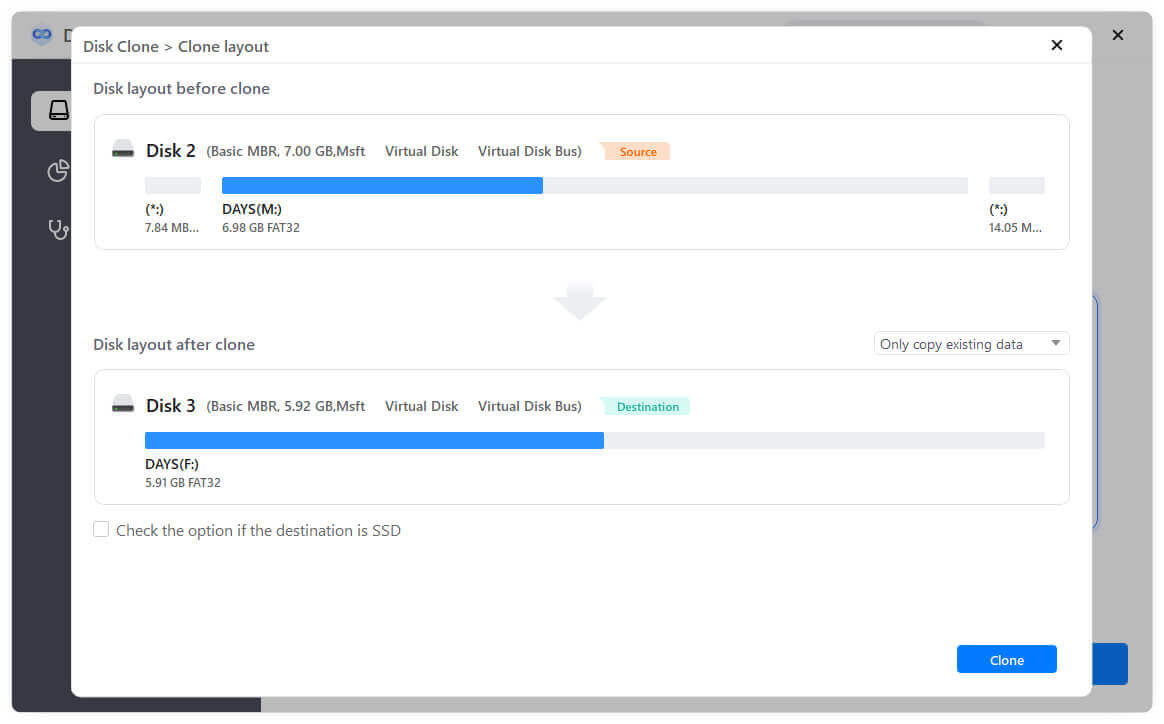Before we start: To make a full and bootable clone for your system disk, you can also try the reliable disk cloning software Donemax Disk Clone. The software is professional and robust to make a bootable clone for Windows and Mac.
PAGE CONTENT:
Cloning a disk is a convenient and powerful method for upgrading to a larger or faster drive, backing up your system, or transferring an operating system to a new machine. Acronis True Image, one of the most trusted tools for disk cloning and backup, makes the process seem seamless. However, many users encounter a frustrating issue after cloning: the Acronis True Image cloned disk won't boot.

If you've just cloned your hard drive using Acronis True Image and the new drive isn't booting, don't panic. This guide walks you through the most common causes and offers step-by-step fixes to get your cloned disk running again.
Common Causes of a Non-Booting Cloned Disk
Before we dive into the fixes, it's important to understand why a cloned disk might not boot. Some of the most common reasons include:
- Incorrect BIOS/UEFI Settings: The computer might still be trying to boot from the old drive or another device entirely.
- Boot Mode Mismatch: A mismatch between BIOS boot mode (Legacy or UEFI) and the disk partition scheme (MBR or GPT) can prevent the system from booting.
- Cloned Disk Not Set as Primary Boot Device: The system may not recognize the cloned disk unless it's explicitly set as the primary boot option.
- Partition Issues: If the correct partition isn't marked as "active," the system may fail to locate the boot loader.
- Boot Configuration Errors: Corrupted or missing BCD (Boot Configuration Data) can block the startup process.
- Drive Letter Conflicts: Drive letter mismatches, especially in system-reserved or recovery partitions, can cause issues.
- Cloning Errors: The process may not have completed correctly, or critical system files may not have been copied properly.
Preliminary Checks for Cloned Disk Won't Boot Issue
Before applying complex solutions, perform these basic troubleshooting steps:
- Verify Clone Completion - Ensure the clone process completed without errors or warnings.
- Confirm Drive Recognition - Enter BIOS/UEFI and verify that the cloned disk is recognized.
- Disconnect Old Drive - Temporarily disconnect the source disk to avoid confusion during boot.
- Check Boot Order - Make sure the cloned drive is at the top of the boot priority list.
Fixes for Acronis True Image Clone Disk Not Booting
Let's walk through practical steps to fix the issue and get your cloned drive booting.
Fix 1. Change Boot Order in BIOS/UEFI
The most basic but often overlooked step is adjusting the boot order.
- Restart your computer and press the key to enter BIOS/UEFI (commonly Del, F2, or F10).
- Navigate to the Boot section.
- Set your cloned disk as the primary boot device.
- Save and exit (usually F10).
This tells the system to boot from the newly cloned drive.
Fix 2. Match Boot Mode: UEFI vs. Legacy
Boot mode must match the partition style of your cloned disk:
- MBR = Legacy BIOS
- GPT = UEFI
How to Check and Switch:
- Boot into BIOS/UEFI.
- Find the boot mode setting and switch between Legacy and UEFI depending on your disk style.
- If necessary, convert MBR to GPT using mbr2gpt or AOMEI Partition Assistant.
Convert MBR to GPT Using Command Prompt:
mbr2gpt /convert /allowFullOS
Backup your data before running disk conversion tools.
Fix 3. Mark the Correct Partition as Active
Without an active partition, the system won't know where to look for boot files.
- Boot from a Windows installation media or recovery disk.
- Open Command Prompt.
- Run the following commands:
diskpart
list disk
select disk X
list partition
select partition Y
active
exitReplace X with your cloned disk number, replace Y with the system partition.
Reboot and check if the problem is solved.
Fix 4. Rebuild Boot Configuration Data (BCD)
A missing or damaged BCD store is a common cause of boot failure.
- Boot from a Windows installation or recovery USB.
- Choose "Repair your computer" → "Troubleshoot" → "Command Prompt".
- Run the following commands:
bootrec /fixmbr
bootrec /fixboot
bootrec /scanos
bootrec /rebuildbcd
These commands attempt to restore the boot record and recognize your cloned OS.
Fix 5. Run Startup Repair
If rebuilding the BCD doesn't work, let Windows try to fix itself.
- Boot from Windows installation media.
- Select "Repair your computer" → "Troubleshoot" → "Startup Repair".
- Choose the target OS (your cloned drive) and let Windows run diagnostics.
Fix 6. Reassign Drive Letters
Windows can become confused if system drive letters change unexpectedly.
- Open Command Prompt via recovery tools.
- Run:
diskpart
list volume
select volume X
assign letter=C
exit
Be cautious when assigning drive letters, especially to system or reserved partitions.
Fix 7. Verify the System Partition
Make sure the system files are on the correct partition. You can check it using Disk Management on another PC:
- Connect the cloned disk to another working PC (if needed).
- Use Disk Management to view which partition is marked as "System" and "Active".
- If needed, use tools like MiniTool Partition Wizard to fix misaligned partitions.
Alternative Solutions to Fixing the Boot Issue
If you've gone through the standard troubleshooting steps and your cloned disk still refuses to boot, don't give up yet. Sometimes, underlying problems aren't obvious at first glance. Whether it's a minor oversight or a deeper compatibility issue, trying these alternative approaches can often resolve the issue without the need to start from scratch.
Re-Clone Using Sector-by-Sector Cloning
Standard cloning usually skips unused blocks or files that seem irrelevant to reduce the clone size and duration. However, in some cases, this optimization can skip over essential boot records or hidden system partitions. That's where sector-by-sector cloning becomes vital.
Why it Works:
- Copies every byte of the source disk, including unallocated and boot sectors
- Ensures exact replication of the source system, including hidden metadata
How to Do It in Acronis True Image:
- Launch Acronis True Image.
- Choose "Clone Disk" → "Manual Mode".
- Select "Sector-by-sector clone" during the setup wizard.
- Proceed with the rest of the cloning steps as normal.
💡 Note: This method takes longer and requires a destination disk with at least the same or greater capacity.
Use Acronis Bootable Media Instead of Cloning from Windows
Sometimes, cloning from within Windows can cause locked files and services to interfere with system file copying—especially those related to boot configuration.
Benefits of Bootable Media:
- Avoids OS-level file locks
- Ensures clean environment during the cloning process
- Reduces risk of corrupted or skipped files
Steps to make bootable media and clone again:
- Open Acronis True Image.
- Navigate to Tools > Rescue Media Builder.
- Create a bootable USB stick with the Acronis environment.
- Boot your PC from the USB.
- Clone your disk from this offline environment.
This approach is ideal for users cloning OS drives and looking for maximum cloning reliability.
Try Different Cloning Software
If Acronis True Image continues to produce boot failures even after adjustments, the issue may be due to software compatibility, version bugs, or limitations in how Acronis handles your specific hardware. Trying a different tool can help determine whether the issue is software-related.
- Simple UI, supports cloning entire disk or single partition
- Built-in SSD alignment and sector-by-sector options
Donemax Disk Clone
- Reliable and professional disk copy software.
- Create bootable clone for system disk.
- 100% safe and easy-to-use.
The software is simple to handle and make a bootable clone for your system disk. Here we will offer a short tutorial for you:
Step 1. Run the software and use the first mode Disk Clone. Choose the system disk as the source drive and another empty disk as destination drive. Click Next.

Step 2. Change the disk layout if needed. If the destination drive is an SSD, ensure to tick "Check the option is the destination is SSD" box. Click Clone button and it will start to make a bootable clone for the system disk.

Macrium Reflect (Free & Paid)
- User-friendly interface
- Supports UEFI, GPT, Secure Boot, and incremental backup options
- Powerful fix boot utility included
Clonezilla (Free & Open Source)
- Advanced features for IT professionals
- Handles disk image restoration, sector-based cloning, and recovery
- Not user-friendly for beginners
💡 Tip: Use one of these tools to re-clone your disk, and compare the results. In some cases, another software may resolve the post-cloning boot problems that Acronis could not.
Restore from Acronis Backup Instead of Cloning
Cloning is great for simple upgrades or migrations, but if your system includes multiple partitions, encrypted volumes, or hybrid configurations (like SSD + HDD cache setups), disk imaging might be a more reliable method.
If cloning fails repeatedly and you had previously created a full Acronis backup (as recommended), consider restoring the system using the backup image instead of cloning.
Why this Works:
- Backup images often include metadata that helps with boot configuration
- Restoration ensures that all boot files and OS partitions are in place as they were originally
How to Restore a Backup:
- Boot from Acronis Bootable Media.
- Choose "Recovery" → "My Disks".
- Locate your full disk image backup.
- Select the target drive (your new disk).
- Complete the recovery process and reboot.
Use Case:
- Ideal when replacing storage with a different form factor (e.g., 2.5" SATA to M.2 NVMe)
- Allows you to store a backup and restore when needed, rather than performing live migration
Check Firmware and Driver Compatibility
Lastly, ensure the following:
- Your SSD/HDD has the latest firmware update
- Motherboard chipset drivers and storage controller drivers (especially Intel RST or AHCI) are up-to-date
- BIOS/UEFI is updated to the latest stable version
Sometimes, firmware or driver conflicts prevent newly cloned drives from being recognized properly during the boot phase.
Tips to Prevent Cloned Disk Not Booting for Next Time
To avoid problems in the future, consider these best practices:
Pre-Cloning Preparation
- Run chkdsk and S.M.A.R.T. checks on the source disk
- Disable hibernation and encryption (e.g., BitLocker)
Disconnect Extra Drives
- After cloning, disconnect the source disk before first boot
- Prevents conflicts and helps OS initialize the new disk as the boot drive
Always Backup Before Cloning
Even cloning software can fail—always have a full backup before proceeding.
Keep Acronis Updated
Check for the latest software version for bug fixes and better compatibility.
Conclusion
Facing a non-booting cloned disk after using Acronis True Image can be stressful, especially when you expect a seamless transition. Fortunately, most boot issues stem from fixable causes—ranging from BIOS settings to boot record errors. By following the structured approach outlined above, you should be able to identify and fix the problem.
Take your time with each fix, ensure you're matching BIOS modes correctly, and don't hesitate to use recovery tools like Startup Repair or bootrec commands. And most importantly, always prepare with backups and proper tools before starting a cloning operation.
With the right approach, your cloned disk will be up and running—saving you time, effort, and frustration.

Donemax Disk Clone
An award-winning disk cloning program to help Windows users and Mac users clone HDD/SSD/external device. It also can create full bootable clone backup for Windows PCs and Macs.
Related Articles
- Apr 21, 2024How to Replace A Hard Drive in HP Laptops
- Apr 27, 2024How to Clone a Hard Drive in Windows Vista?
- May 21, 2024How to Upgrade HDD to SSD on Dell Laptop?
- Jun 19, 2023How to Move OS to Another Drive without Reinstalling and Data Loss
- Jun 21, 2023Best Disk Cloning Software in 2025 [Windows 11 Supported]
- May 10, 2025How to Clone a Hard Drive with Operating System?

Charles
Charles, who lives in Sydney, Australia, is an editor & writer of Donemax Team. He is good at writing articles related with Apple Mac computers, Windows operating systems, data recovery, data erasure, disk clone and data backup, etc. He loves reading and playing tennis in his spare time and is interested in testing new digital devices such as mobile phones, Macs, HDDs, SSDs, digital cameras, etc.

Gerhard Chou
In order to effectively solve the problems for our customers, every article and troubleshooting solution published on our website has been strictly tested and practiced. Our editors love researching and using computers and testing software, and are willing to help computer users with their problems
